
paleo diet plan pdf
The Paleo diet‚ also known as the caveman diet‚ focuses on eating unprocessed foods similar to those consumed during the Paleolithic era‚ emphasizing meats‚ fruits‚ and vegetables while avoiding grains and dairy. This dietary approach aims to improve health by mimicking the eating habits of early humans‚ promoting weight loss and better digestion.
What is the Paleo Diet?
The Paleo diet‚ also known as the caveman diet‚ is based on eating foods that were available to humans during the Paleolithic era‚ approximately 2.5 million to 10‚000 years ago. It focuses on consuming unprocessed‚ natural foods such as lean meats‚ fish‚ fruits‚ vegetables‚ nuts‚ and seeds while avoiding modern foods like grains‚ dairy‚ legumes‚ and processed items. The diet aims to mimic the eating habits of early humans‚ promoting weight loss‚ improved digestion‚ and overall health by eliminating foods that our bodies are not genetically adapted to process effectively. This approach emphasizes whole‚ nutrient-rich foods to support optimal well-being.
Historical Background of the Paleo Diet
The Paleo diet is rooted in the eating habits of early humans‚ dating back to the Paleolithic era‚ approximately 2.5 million to 10‚000 years ago. During this period‚ humans primarily consumed foods they could hunt or gather‚ such as meats‚ fish‚ fruits‚ vegetables‚ nuts‚ and seeds. The diet gained modern popularity in the 1970s through the work of Walter Voegtlin‚ who advocated for a diet based on evolutionary principles. It further rose to prominence in the 21st century with the publication of books like The Paleo Diet by Loren Cordain‚ making it a mainstream approach to improving health and losing weight naturally.
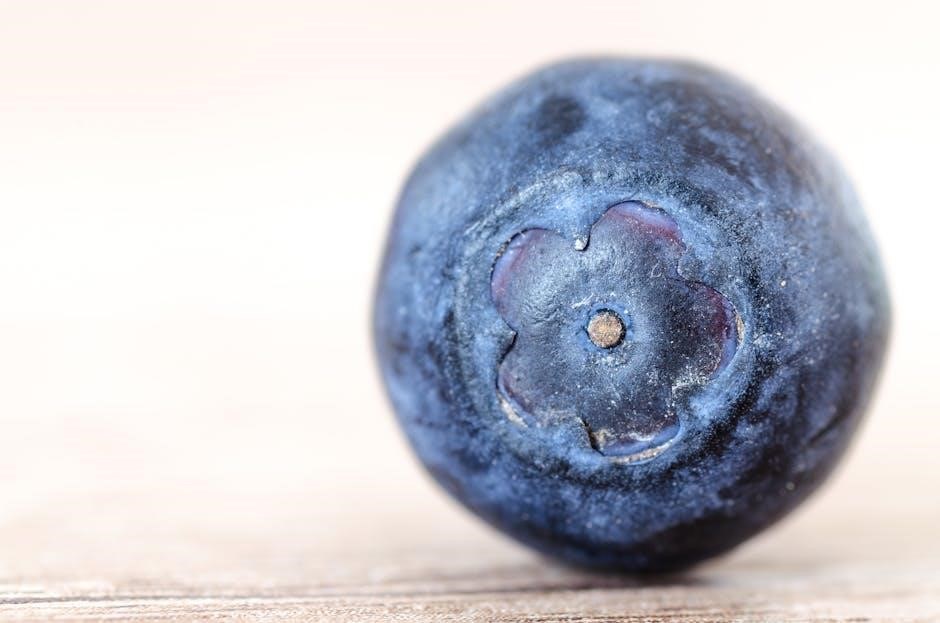
Key Principles of the Paleo Diet
The Paleo diet centers on consuming only foods available during the Paleolithic era‚ excluding modern‚ processed items. Core principles include eliminating grains‚ dairy‚ legumes‚ added sugars‚ and processed foods. Emphasis is placed on whole‚ nutrient-dense foods like lean meats‚ fish‚ fruits‚ vegetables‚ nuts‚ and seeds. The diet encourages avoiding harmful substances like trans fats and artificial additives‚ promoting natural‚ unprocessed ingredients instead. By focusing on these principles‚ the Paleo diet aims to align modern eating habits with evolutionary biology‚ fostering improved health and weight management through a return to ancestral dietary practices.
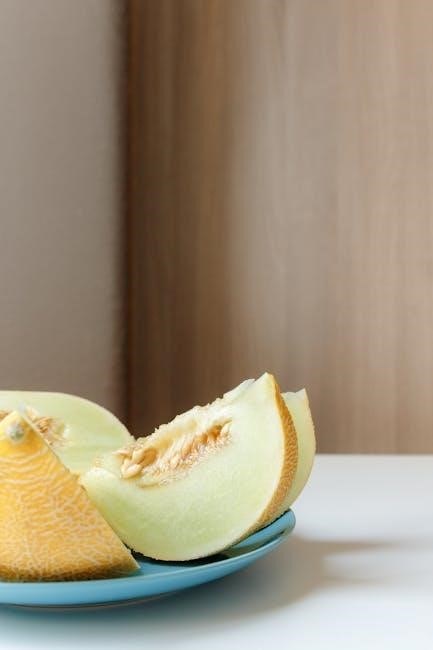
Benefits of the Paleo Diet
The Paleo Diet aids in weight loss and enhances body composition. It improves digestion and reduces inflammation‚ boosting energy levels and overall health effectively.
Weight Loss and Improved Body Composition
The Paleo Diet promotes significant weight loss by focusing on whole‚ nutrient-dense foods. By eliminating processed carbs and sugars‚ it helps reduce insulin levels‚ fostering fat burning. The diet’s emphasis on lean proteins and healthy fats supports muscle retention‚ improving body composition. Many followers report enhanced metabolism and reduced inflammation‚ which further aids in shedding pounds. The Paleo approach also encourages mindful eating‚ helping individuals develop healthier relationships with food. With its balanced macronutrient intake‚ the diet not only aids in weight loss but also supports long-term fat loss and a leaner physique. This makes it an effective choice for those seeking sustainable body transformation.
Improved Digestion and Reduced Inflammation
The Paleo Diet often leads to improved digestion and reduced inflammation due to its focus on whole‚ unprocessed foods. By eliminating grains‚ legumes‚ and dairy‚ which can cause digestive discomfort for some‚ the diet promotes a healthier gut. The emphasis on fruits‚ vegetables‚ and lean proteins provides essential nutrients and fiber‚ aiding digestion. Additionally‚ the Paleo Diet avoids pro-inflammatory foods like processed sugars and refined carbs‚ which can contribute to chronic inflammation. Many followers report reduced symptoms of bloating‚ indigestion‚ and irritable bowel syndrome. This dietary approach not only supports digestive health but also helps mitigate inflammation‚ fostering overall well-being and energy levels.
Increased Energy Levels and Better Overall Health
The Paleo Diet is known to boost energy levels by focusing on nutrient-dense foods that stabilize blood sugar and provide sustained energy. By eliminating processed foods and added sugars‚ which cause energy crashes‚ the diet promotes consistent vitality. The emphasis on lean meats‚ fish‚ and healthy fats supports optimal brain function and physical performance. Followers often report enhanced mental clarity and reduced fatigue. Additionally‚ the diet’s anti-inflammatory properties contribute to better overall health‚ reducing the risk of chronic diseases like heart disease and diabetes. This holistic approach not only energizes the body but also supports long-term health and well-being.
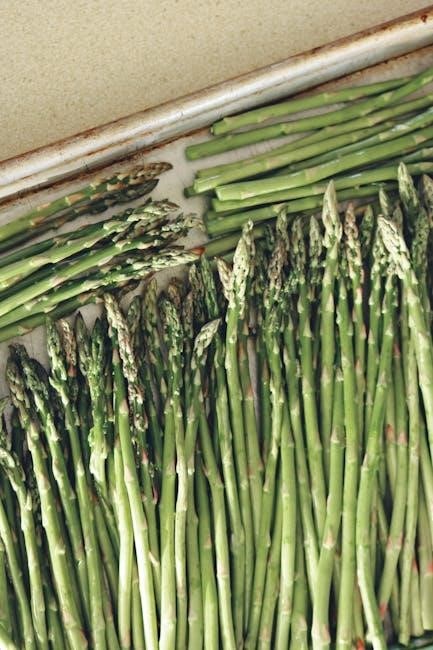
7-Day Paleo Diet Meal Plan
A structured Paleo meal plan focusing on whole‚ nutrient-rich foods like meats‚ fish‚ fruits‚ vegetables‚ nuts‚ and seeds‚ ensuring variety and simplicity for each day’s breakfast‚ lunch‚ dinner‚ and snacks.
Day 1: Breakfast‚ Lunch‚ Dinner‚ and Snack Ideas
Start your day with a Paleo-friendly breakfast: scrambled eggs with spinach and mushrooms‚ paired with a handful of fresh berries. For lunch‚ enjoy a grilled chicken salad with mixed greens‚ avocado‚ and a citrus vinaigrette. Dinner could feature baked salmon with roasted sweet potatoes and steamed broccoli. As a snack‚ opt for a handful of hazelnuts or sliced cucumbers with a sprinkle of sea salt. This meal plan is designed to be nutrient-dense‚ flavorful‚ and easy to prepare‚ ensuring a strong start to your Paleo journey.
Day 2: Breakfast‚ Lunch‚ Dinner‚ and Snack Ideas
Begin Day 2 with a hearty breakfast of a vegetable omelette made with eggs‚ zucchini‚ and bell peppers‚ served alongside a side of fresh pineapple slices. For lunch‚ prepare a grilled chicken salad with mixed greens‚ cherry tomatoes‚ and a drizzle of olive oil and lemon juice. Dinner could feature a beef stir-fry with coconut aminos‚ broccoli‚ and cauliflower rice. As a snack‚ enjoy a small handful of almonds or a serving of sliced cucumber with a sprinkle of salt. These meals are designed to be balanced‚ flavorful‚ and aligned with Paleo principles‚ ensuring you stay satisfied and energized throughout the day.
Day 3: Breakfast‚ Lunch‚ Dinner‚ and Snack Ideas
Start Day 3 with a Paleo breakfast of scrambled eggs with avocado and crispy bacon‚ paired with a side of mixed berries. For lunch‚ enjoy a grilled salmon fillet served with a colorful medley of roasted vegetables like asparagus‚ carrots‚ and Brussels sprouts. Dinner could feature tender pork chops seasoned with garlic and herbs‚ alongside a hearty serving of sautéed spinach and sweet potatoes. As a snack‚ try a handful of walnuts or a serving of sliced celery with almond butter. These meals are nutrient-dense and flavorful‚ ensuring you stay on track with your Paleo diet while keeping your taste buds satisfied and your energy levels steady throughout the day.

Day 4: Breakfast‚ Lunch‚ Dinner‚ and Snack Ideas

Begin Day 4 with a hearty breakfast of a Paleo smoothie made with coconut milk‚ frozen berries‚ and a handful of spinach‚ topped with chia seeds. For lunch‚ enjoy a grilled turkey lettuce wrap filled with sliced avocado‚ tomato‚ and a drizzle of olive oil‚ paired with a side of cucumber slices. Dinner features a juicy beef stir-fry with zucchini noodles‚ bell peppers‚ and onions‚ seasoned with garlic and ginger. Snack on a small apple with a tablespoon of almond butter or a handful of mixed nuts like almonds and cashews. These meals provide balanced nutrition and delicious flavors to keep your energy levels up throughout the day.
Day 5: Breakfast‚ Lunch‚ Dinner‚ and Snack Ideas
Start Day 5 with a protein-packed breakfast of scrambled eggs with diced mushrooms and spinach‚ served alongside a slice of fresh melon. For lunch‚ try a grilled salmon salad with mixed greens‚ cherry tomatoes‚ and a lemon-tahini dressing. Dinner features a hearty beef and vegetable kebab‚ with zucchini‚ bell peppers‚ and onions‚ grilled to perfection. Snack on a handful of fresh berries or a small serving of sliced cucumbers with a sprinkle of sea salt. These meals are designed to keep you satisfied and fueled while staying true to Paleo principles of whole‚ unprocessed foods.
Day 6: Breakfast‚ Lunch‚ Dinner‚ and Snack Ideas
Begin Day 6 with a nourishing breakfast of avocado and tomato stuffed eggs‚ seasoned with a pinch of salt and pepper. For lunch‚ enjoy a grilled turkey lettuce wrap with sliced cucumbers‚ carrots‚ and a drizzle of olive oil. Dinner features a pan-seared pork chop paired with roasted asparagus and Brussels sprouts‚ lightly tossed in coconut oil. Snack on a small bowl of mixed nuts‚ such as almonds and cashews‚ or try crispy baked courgette chips for a satisfying crunch. These meals are crafted to keep your energy levels steady while adhering to the Paleo diet’s wholesome‚ natural food philosophy.
Day 7: Breakfast‚ Lunch‚ Dinner‚ and Snack Ideas
Start Day 7 with a vibrant breakfast of smoked salmon topped with fresh dill and lemon on a bed of crisp spinach. Pair it with a side of sliced mango for natural sweetness. Lunch features a hearty chicken salad‚ mixed with diced avocado‚ cucumbers‚ and tomatoes‚ dressed lightly with olive oil and a squeeze of lime juice. For dinner‚ savor a tender grilled steak served alongside roasted sweet potatoes and steamed broccoli. Snack on a handful of fresh berries or a spoonful of almond butter for a satisfying treat. These meals wrap up the week with flavorful‚ nutrient-rich options that align with Paleo principles.
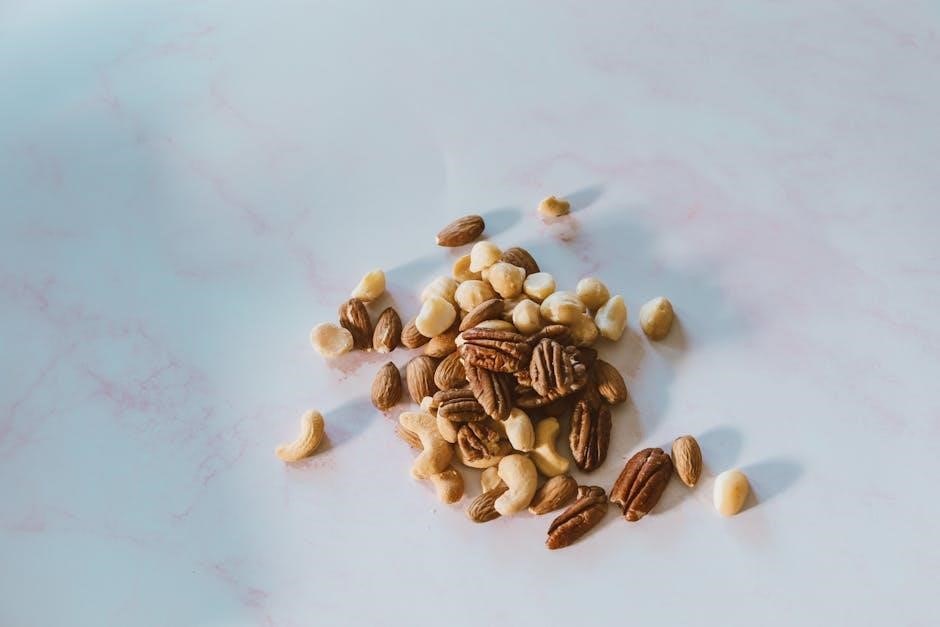
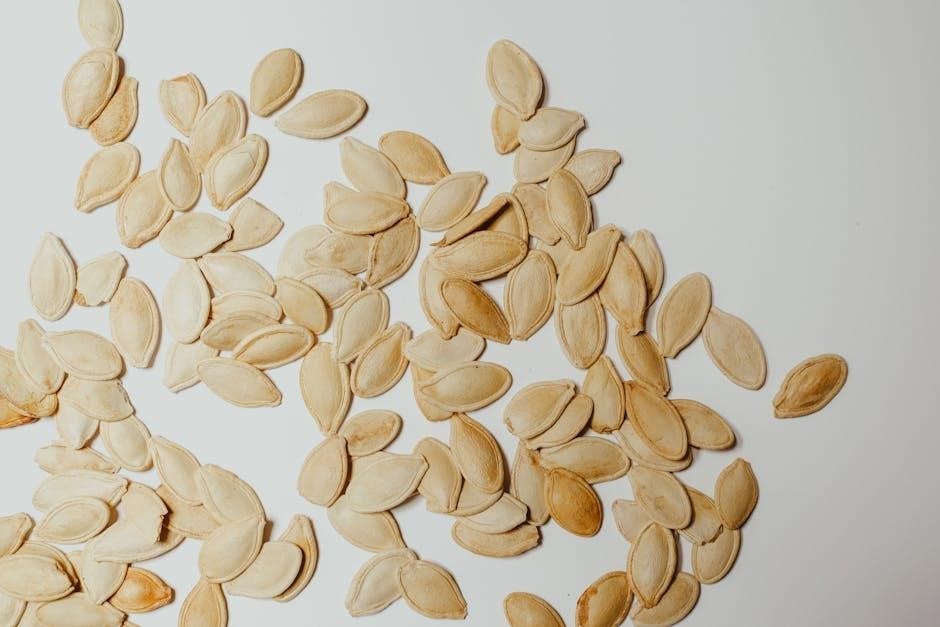
Tips for Following the Paleo Diet
Plan meals weekly‚ shop for fresh produce‚ and avoid processed foods. Incorporate variety to ensure nutritional balance and prevent boredom‚ making the diet sustainable and enjoyable.
How to Plan Your Meals Effectively
Planning meals is crucial for sticking to the Paleo diet. Start by creating a weekly menu‚ ensuring each meal includes a balance of protein‚ vegetables‚ and healthy fats. Make a grocery list with fresh‚ seasonal produce‚ lean meats‚ and nuts. Consider preparing meals in advance‚ such as cooking proteins and chopping vegetables on weekends. Use online resources or Paleo cookbooks for inspiration and variety. Avoid last-minute decisions that may lead to non-Paleo choices by having snacks like nuts or fruits readily available. This approach helps maintain consistency and makes the diet more manageable and sustainable in the long run.
Shopping Tips for Paleo-Friendly Foods
When shopping for Paleo-friendly foods‚ focus on fresh‚ whole ingredients. Visit the produce section for fruits and vegetables‚ and opt for organic or seasonal options when possible. Choose grass-fed meats‚ wild-caught fish‚ and free-range eggs. Avoid processed foods and aisles filled with packaged snacks. Shop the perimeter of the store‚ where whole foods are typically located. Include nuts‚ seeds‚ and healthy oils like olive or coconut oil in your list. Avoid grains‚ legumes‚ and dairy products‚ as they are not part of the Paleo diet. Always read labels to ensure no added sugars or harmful additives are present. Plan ahead and buy in bulk to save time and money.
Common Mistakes to Avoid on the Paleo Diet
Avoiding common mistakes is crucial for success on the Paleo diet. One mistake is overconsumption of nuts and seeds‚ which can lead to excess calorie intake. Another is neglecting to plan meals‚ resulting in reliance on non-Paleo options. Many people forget to drink enough water‚ essential for digestion and overall health. Others may overlook the importance of variety‚ leading to nutrient deficiencies. Avoid assuming all Paleo foods are healthy in large quantities‚ as portions still matter. Skipping meals can disrupt metabolism‚ so maintaining a balanced intake is key. Lastly‚ some individuals may not transition gradually‚ causing unnecessary stress or frustration early in their journey.

Criticisms and Controversies
The Paleo diet has faced criticism for its restrictive nature‚ high cost‚ and lack of scientific evidence supporting long-term health benefits. Some experts argue it may lead to nutrient deficiencies if not properly planned‚ particularly in vitamins and minerals found in excluded food groups like whole grains and dairy.
Arguments Against the Paleo Diet
Critics argue that the Paleo diet is overly restrictive‚ eliminating entire food groups like whole grains and legumes‚ which are rich in essential nutrients. The diet’s focus on high-cost‚ organic meats can be impractical for many individuals. Additionally‚ the lack of scientific evidence supporting its long-term benefits has raised concerns. Some experts point out that modern humans have evolved significantly since the Paleolithic era‚ making the diet less relevant today. Furthermore‚ the diet’s emphasis on meat consumption has drawn criticism for potential environmental and health impacts‚ such as increased saturated fat intake and higher greenhouse gas emissions.
Addressing Nutritional Concerns
The Paleo diet has raised concerns about nutrient deficiencies due to its restrictive nature. Critics highlight the potential lack of calcium‚ fiber‚ and vitamins from eliminated food groups like dairy and whole grains. To mitigate these risks‚ followers often need to carefully plan their meals or consider supplements. For instance‚ nuts and leafy greens can provide calcium‚ while fruits and vegetables supply fiber. However‚ ensuring adequate intake of all essential nutrients requires attention and may not be feasible for everyone. This underscores the importance of consulting a nutritionist to avoid deficiencies while adhering to the Paleo lifestyle.
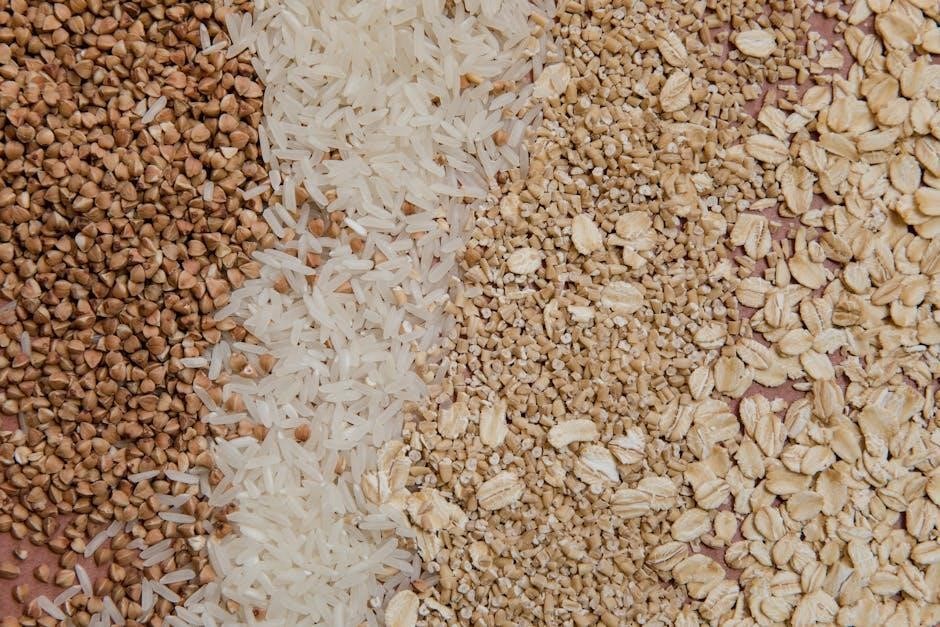
Long-Term Sustainability
The Paleo diet’s long-term sustainability depends on commitment and proper planning. While some find it manageable‚ others struggle with its restrictive nature and meal preparation demands.
Is the Paleo Diet a Lifestyle Change?
Adopting the Paleo diet often requires significant changes to daily habits‚ making it more than just a diet—it’s a lifestyle shift. It involves eliminating entire food groups like grains‚ dairy‚ and processed foods‚ which can be challenging for many. The Paleo diet encourages a focus on fresh‚ whole foods‚ which may necessitate new cooking skills and meal planning strategies. Over time‚ many find that the Paleo diet fosters healthier eating habits and a greater connection to the food they consume‚ transforming it into a sustainable way of living rather than a temporary fix.
How to Maintain the Paleo Diet Long-Term
Maintaining the Paleo diet long-term requires consistent effort and planning. Staying organized with meal prepping and grocery shopping is essential to avoid setbacks. Incorporating a variety of Paleo-friendly foods helps keep meals interesting and prevents boredom. Building a support system‚ such as joining Paleo communities or sharing meals with like-minded individuals‚ can also enhance sustainability. Additionally‚ focusing on long-term health benefits rather than short-term goals can motivate adherence. Over time‚ the Paleo diet can become a natural and enjoyable way of eating‚ promoting overall well-being and lifestyle balance.
The Paleo diet offers a sustainable approach to improving health and weight management by focusing on whole‚ unprocessed foods‚ promoting long-term wellness and a balanced lifestyle.
Final Thoughts on the Paleo Diet
The Paleo diet is a simple yet effective approach to improving overall health by focusing on whole‚ unprocessed foods. By eliminating grains‚ dairy‚ and processed items‚ individuals often experience weight loss‚ improved digestion‚ and increased energy levels. While it may require significant changes to daily eating habits‚ the Paleo diet offers a sustainable path to long-term wellness. Many followers report feeling more energetic and experiencing fewer chronic health issues‚ making it a worthwhile option for those seeking a lifestyle change. With proper planning and commitment‚ the Paleo diet can be a transformative way to achieve better health and vitality.
Resources for Further Reading and Meal Planning
For those interested in exploring the Paleo diet further‚ numerous resources are available online and in print. Books like The Paleo Diet by Loren Cordain and The Paleo Solution by Robb Wolf provide comprehensive guides. Websites such as Paleoleap and Nom Nom Paleo offer recipes‚ meal plans‚ and tips for adhering to the diet. Additionally‚ downloadable PDF guides and mobile apps like Paleo Diet Planner can help track meals and stay organized. These resources cater to both beginners and experienced followers‚ ensuring a smooth transition to a Paleo lifestyle with creative and delicious meal ideas to keep things interesting and satisfying.